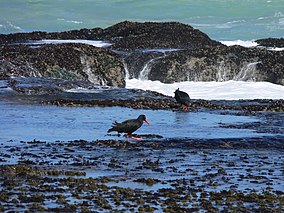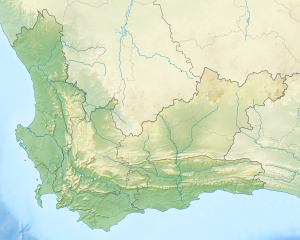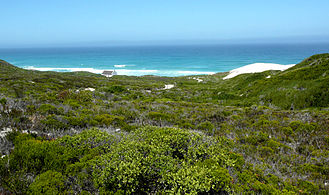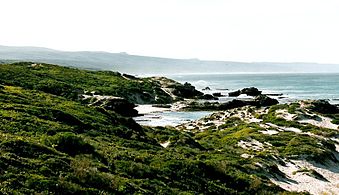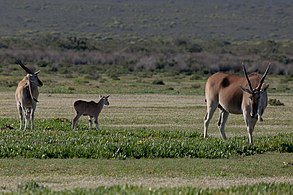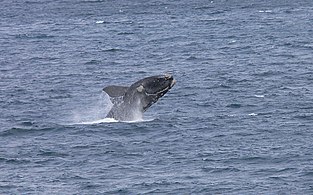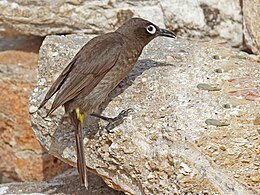
The Drakensberg is the eastern portion of the Great Escarpment, which encloses the central Southern African plateau. The Great Escarpment reaches its greatest elevation – 2,000 to 3,482 metres within the border region of South Africa and Lesotho.

The Prince Edward Islands are two small uninhabited volcanic islands in the sub-Antarctic Indian Ocean that are administered by South Africa. They are named Marion Island and Prince Edward Island.

Swellendam is the third oldest town in South Africa, a town with 17,537 inhabitants situated in the Western Cape province. The town has over 50 provincial heritage sites, most of them buildings of Cape Dutch architecture. Swellendam is situated on the N2, approximately 220 km from both Cape Town and George.

Gansbaai is a fishing town and popular tourist destination in the Overberg District Municipality, Western Cape, South Africa. It is known for its dense population of great white sharks and as a whale-watching location.
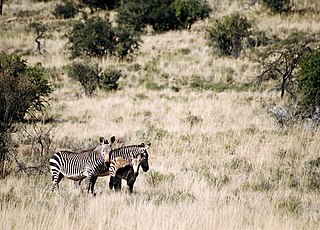
Mountain Zebra National Park is a national park in the Eastern Cape province of South Africa; established in July 1937 for the purpose of providing a nature reserve for the endangered Cape mountain zebra. It is surrounded by 896,146 hectares of the Mountain Zebra-Camdeboo Protected Environment.

Addo Elephant National Park (AENP) is a diverse wildlife conservation park situated close to Gqeberha in South Africa and is one of the country's 20 national parks. It currently ranks third in size after Kruger National Park and the Kgalagadi Transfrontier Park.

Table Mountain National Park, previously known as the Cape Peninsula National Park, is a national park in Cape Town, South Africa, proclaimed on 29 May 1998, for the purpose of protecting the natural environment of the Table Mountain chain, and in particular the rare fynbos vegetation. The park is managed by South African National Parks. The property is included as part of the UNESCO Cape Floral Region World Heritage Site.

Helderberg refers to a planning district of the City of Cape Town metropolitan municipality, the mountain after which it is named, a wine-producing area in the Western Cape province of South Africa, or a small census area in Somerset West.

The Hottentots Holland Mountains are part of the Cape Fold Belt in the Western Cape, South Africa. The mountain range forms a barrier between the Cape Town metropolitan area and the southern Overberg coast.

The wildlife of Jordan includes its flora and fauna and their natural habitats. Although much of the country is desert, it has several geographic regions, each with a diversity of plants and animals adapted to their own particular habitats. Fossil finds show that in Palaeolithic times, the region had Syrian brown bears, Asiatic lions and Syrian elephants, but these species are all now extinct in this region.

The wildlife of Cape Verde is found across its archipelago of ten islands and three islets, albeit in smaller numbers of species than mainland Africa. Each volcanic island within the archipelago is unique, and each of them have parks under their jurisdiction, by decree promulgated by the Cape Verde government. Located just off the west coast of Africa, the total land area of the island nation is 4,564 square kilometres (1,762 sq mi).

The wildlife of South Africa consists of the flora and fauna of this country in Southern Africa. The country has a range of different habitat types and an ecologically rich and diverse wildlife, vascular plants being particularly abundant, many of them endemic to the country. There are few forested areas, much savanna grassland, semi-arid Karoo vegetation and the fynbos of the Cape Floristic Region. Famed for its national parks and big game, 297 species of mammal have been recorded in South Africa, as well as 849 species of bird and over 20,000 species of vascular plants.

The West Coast National Park lies 88 km (55 mi) north of Cape Town in the Western Cape province of South Africa. The park is found inside of the Cape West Coast Biosphere Reserve, part of the UNESCO Man and the Biosphere Programme. It is bordered by the Atlantic Ocean on the west and the R27 coastal road, and runs from the town of Yzerfontein in the south, up to the Langebaan Lagoon. The park is particularly well known for its bird life and for the spring flowers which occur in the months from August to September, especially in the Postberg flower reserve section of the park. The park, with the islands in Saldanha Bay, has been identified by BirdLife International as an Important Bird Area. The park was proclaimed in 1985, and is 36,259.8 hectares (140.000 sq mi) in size.
Thomas Baines Nature Reserve is a 1,005-hectare (2,480-acre) nature reserve in the Eastern Cape, South Africa that is managed by Eastern Cape Parks. It was created as a municipal reserve in 1961 and upgraded to a provincial reserve in 1980. It is named after the artist and explorer Thomas Baines who recorded the region's flora and fauna.

Kogelberg Nature Reserve is a nature reserve of 3,000 ha comprising the Kogelberg Mountain Range, to the east of Cape Town, South Africa.

Koryak Nature Reserve is a Russian 'zapovednik' Located in the north of the Kamchatka Peninsula, in the valley of the Kuyul River in the Russian Far East, and in separate coastal areas on the coast of the Bering Sea. The reserve includes the surrounding mountains of the Gauvin Peninsula and adjacent waters in Lavrov Bay, and one fourth of the total area covers waters of the Bering Sea. Koryak is an important area for large colonies of nesting waterfowl and migratory seabirds; studies have found that the majority of the seabirds migrating along the Kamchatka Peninsula spend their winters in Japan. Protecting this connection was one of the reasons for the establishment of the reserve in 1995. The rivers of Koryak are important spawning grounds for salmon. Also protected are the floral communities of the reserve, which include prime examples of "Bering forest tundra". The reserve is situated in the Koryak Okrug of Kamchatka Krai. The reserve covers an area of 327,106 ha (1,262.96 sq mi). The site is part of a Ramsar wetland area of international importance.

The De Hoop Marine Protected Area lies between Arniston and the mouth of the Breede River on the south coast of South Africa adjacent to the De Hoop Nature Reserve. The MPA is 51 kilometres long, and extends 5 nautical miles to sea. The whole MPA is a restricted area and is part of the migratory route and calving area for Southern right whales. The area protects habitats for several economically important inshore reef fish species, and ensures the retention of marine biomass in this part of the coast. The limestone coastline is includes archaeological sites and middens that date back centuries. The MPA is close to the Breede River estuary and, provides protection for species like cob that breed in the estuary and then return to the ocean.
The Addo Elephant National Park Marine Protected Area is a marine conservation area in Algoa Bay, adjacent to the Nelson Mandela Bay Metropolitan Municipality, near Gqeberha, previously Port Elizabeth.
The Rocherpan Marine Protected Area is a small coastal conservation region on the West Coast of the Western Cape province, in the territorial waters of South Africa. It is about 25 km north of Velddrif on the road to Elands Bay, north of Dwarskersbos.
